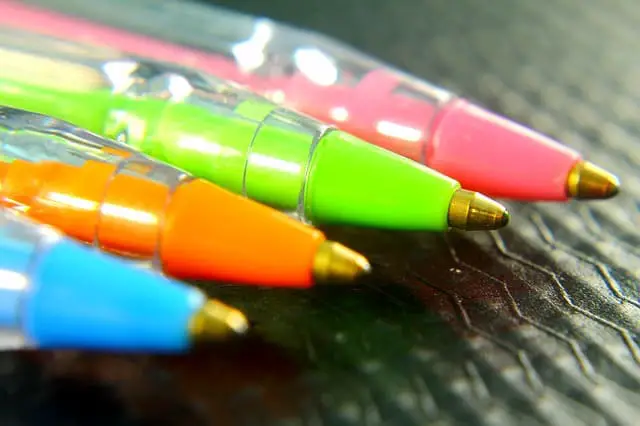The Fascinating Story Behind Ballpoint Pens
The history of ballpoint pens is an intriguing narrative of creativity and progress. Invented by Laszlo Biro and his brother Gyorgy, the first patented ballpoint pen transformed the world of writing instruments. Initially designed for the Hungarian newspaper industry, these pens gained rapid popularity for their fast-drying ink and seamless writing experience.
Recognizing their potential, the British government acquired the rights to use them for the Royal Air Force. Today, ballpoint pens are widely appreciated for their reliability, versatility, and affordability.
This article will explore their origins, mechanics, advantages, and differences from rollerball pens and highlight notable brands.
Key Takeaways
- The ballpoint pen was invented by Laszlo Biro and his brother Gyorgy, who developed a ball-socket writing instrument with quick-drying ink.
- The British government bought the rights to the pens for the Royal Air Force.
- Other inventors like Milton Reynolds and Marcel Bich created their ballpoint pens.
- Ballpoint pens have a reservoir that holds paste-like ink, and when the pen is pressed on paper, the ball spins and transfers ink to the writing surface.
The Inventor and the First Patented Ballpoint Pen
Hungarian newspaper editor Laszlo Biro is credited with inventing the first patented ballpoint pen, a writing instrument with quick-drying ink developed by him and his brother, Gyorgy.
In the 1930s, Laszlo Biro became frustrated with the slow-drying fountain pens commonly used. He wanted a pen that could write smoothly and quickly without smudging. They created a ball-socket pen with his brother that used a tiny metal ball to distribute ink onto paper.
The ballpoint pen revolutionized the writing industry and quickly gained popularity. The British government recognized the pen’s potential and bought its rights for the Royal Air Force.
Today, ballpoint pens are widely used and come in various designs, colors, and brands.
The Journey to Commercial Success
The journey to commercial success for ballpoint pens involved overcoming initial challenges and establishing partnerships with governments and innovative inventors.
The invention of the ballpoint pen by Laszlo Biro and his brother, Gyorgy, was met with skepticism and resistance. However, the British government recognized the potential of this writing instrument and bought the rights to the pens for the Royal Air Force. This endorsement paved the way for the widespread adoption of ballpoint pens.
Other inventors, such as Milton Reynolds and Marcel Bich, also played a significant role in developing and popularizing ballpoint pens.
Today, ballpoint pens are produced by renowned brands such as Bic, Paper Mate, Pentel, and Pilot, each offering various options to cater to different preferences and budgets.
The journey to commercial success was not without its challenges. Still, through perseverance and strategic partnerships, ballpoint pens have become one of the world’s most widely used writing instruments.
Innovations and Competing Designs
Innovations and competing designs have contributed to the evolution of ballpoint pens, with various advancements in ink technology, pen construction, and ergonomic designs.
Over the years, manufacturers have continuously strived to improve the writing experience and meet the diverse needs of consumers.
Ink technology has significantly improved quick-drying, smear-resistant, and long-lasting inks.
Pen construction has also changed, incorporating lightweight materials, retractable mechanisms, and improved grip designs.
Additionally, ergonomic designs have been introduced to ensure comfortable and fatigue-free writing.
These innovations have not only enhanced the performance and durability of ballpoint pens but have also provided users with a wide range of options to choose from, making ballpoint pens a popular choice for everyday writing tasks.
The Mechanics Behind Ballpoint Pens
Ballpoint pens operate through the rotational motion of a metal ball that transfers ink from the reservoir to the writing surface. The ball, usually made of steel, brass, or tungsten carbide, is enclosed at the end of the pen. When pressure is applied to the pen on paper, the ball spins freely, picking up the ink from the reservoir and transferring it onto the paper.
The ink in ballpoint pens is thick and oil-based, allowing for quick drying and minimal smudging. This makes ballpoint pens ideal for left-handed writers and tasks requiring shading, such as art and design.
Additionally, ballpoint pens are known for their durability and long-lasting ink, making them popular among consumers.
The Advantages of Using Ballpoint Pens
One advantage of using ballpoint pens is their ability to dry quickly, making them suitable for left-handed writers and tasks that require minimal smudging. The thick, oil-based ink in ballpoint pens allows it to dry rapidly on paper, preventing smearing and smudging.
This is particularly beneficial for left-handed writers who drag their hands across the page as they write. The quick-drying ink ensures the writing remains clear and legible without unwanted smudges.
Additionally, ballpoint pens are ideal for tasks that involve shading, such as artwork and industrial design, as the fast-drying ink allows for precise control and layering. Overall, the ability of ballpoint pens to dry quickly enhances their usability and versatility for various writing and creative endeavors.
| Advantages of Ballpoint Pens | |
|---|---|
| Dries quickly | Suitable for left-handed writers and tasks requiring minimal smudging |
| Minimal bleeding | Ink rarely bleeds through papers |
| Great for shading | Ideal for artists and industrial designers |
| Low maintenance | Less finicky, no frequent refills or ink dipping |
The Distinction: Ballpoint vs. Rollerball Pens
The distinction between ballpoint and rollerball pens lies in the type of ink used and the writing experience they offer.
Ballpoint pens use viscous ink, resulting in a scratchier writing experience. The ink dries quickly, eliminating smudging and making them suitable for left-handed writers.
On the other hand, rollerball pens use watery ink, providing a smoother writing experience. However, the rapid ink release leads to slower drying time and quicker ink depletion.
While ballpoint pens are more economical due to their longer-lasting ink, rollerball pens offer a more enjoyable writing experience with smooth and fluid ink flow.
Ultimately, the choice between ballpoint and rollerball pens depends on personal preferences and the specific writing needs of the individual.
Notable Ballpoint Pen Brands
Bic®, Paper Mate®, Pentel®, and Pilot® are well-established brands that offer a diverse range of ballpoint pen options.
Known for their reliability and affordability, Bic® and Paper Mate® have been trusted names in the industry for decades. They provide various ballpoint pens suitable for various writing needs and preferences.
On the other hand, Pentel® and Pilot® are renowned for their quality and innovation in ballpoint pen design. These brands offer pens with advanced features, such as ergonomic grips, smooth ink flow, and vibrant colors.
Whether you are a student, professional, or artist, these brands have covered you with their extensive range of ballpoint pens. With their commitment to excellence, Bic®, Paper Mate®, Pentel®, and Pilot® continue to be the go-to choices for pen enthusiasts worldwide.
Conclusion
In conclusion, the ballpoint pen has a rich history of innovation and has become a widely used and appreciated writing instrument.
From its invention by Laszlo Biro and his brother Gyorgy to the various advancements and designs introduced by inventors like Milton Reynolds and Marcel Bich, the ballpoint pen has evolved into a reliable, versatile, and affordable tool for students, professionals, and artists alike.
With its quick-drying ink and smooth writing experience, the ballpoint pen continues to be a popular choice for many.







